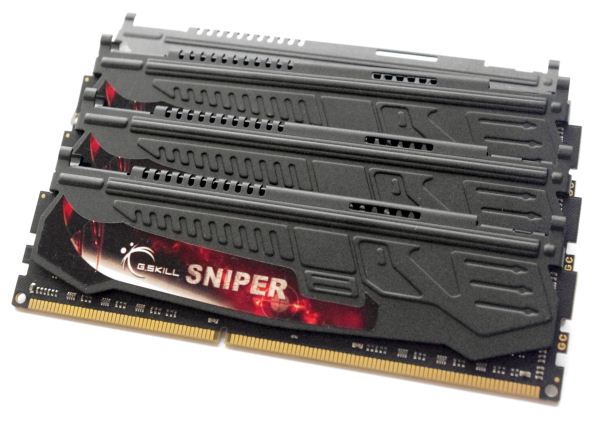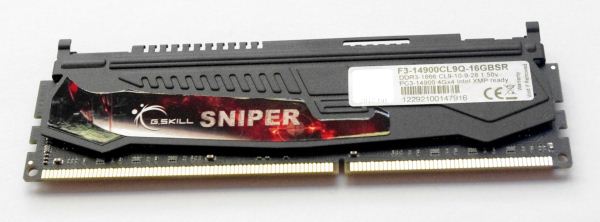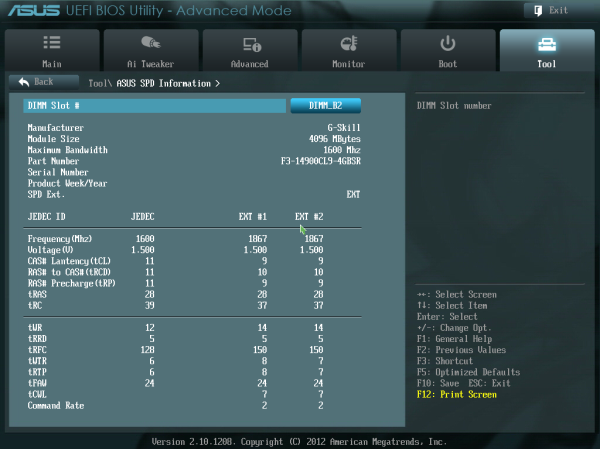Memory Performance: 16GB DDR3-1333 to DDR3-2400 on Ivy Bridge IGP with G.Skill
by Ian Cutress on October 18, 2012 12:00 PM EST- Posted in
- Memory
- G.Skill
- Ivy Bridge
- DDR3
As mentioned in the DDR3-1600 kit, as processors develop the manufacturers raise the minimum speed to which those processors and memory controllers are rated. This means that higher speed memory kits are guaranteed, and as such the market has to adjust – with the high end Trinity processors supporting DDR3-1866 out of the box, the rest of the spectrum will rise to cover this. As a result, the memory manufacturers have to argue for better deals over their ICs, and make sure the design of the ICs will secure higher yields of the faster stuff which they can sell on to the users. Our leap from DDR3-1600 to DDR3-1866 is a leap from an $80 kit to a $95 kit, or an increase in ~19% in the price.
Visual Inspection
The Sniper kits are the oddest of G.Skill’s lineup. As we can see in the images below, the heatsink is shaped like a rifle. Bonus points if you can tell us what rifle it is meant to be. The benefits of having a rifle as a heatsink may point towards building a Gigabyte G-series system or MSI Big Bang XPower rig, both of which take designs using weapons as part of the standard. Apart from this, there is not much benefit to a stylized heatsink such as this – heat dissipation will be similar to the other kits in this review, and the main reason for this heatsink is to protect the user and competition from knowing what ICs are under the hood.
As with the RipjawsX kit, I placed a module of the kit in our system with the TRUE Copper, just to see the effect of having a large air cooler would have on the nearest memory module on a motherboard:
Again due to the height of the module, large air coolers that impinge on the memory slots will cause the Sniper kits to be placed at an angle.
JEDEC + XMP Settings
| G.Skill | |||||
| Kit Speed | 1333 | 1600 | 1866 | 2133 | 2400 |
| Subtimings | 9-9-9-24 2T | 9-9-9-24 2T | 9-10-9-28 2T | 9-11-10-28 2T | 10-12-12-31 2T |
| Price | $75 | $80 | $95 | $130 | $145 |
| XMP | No | Yes | Yes | Yes | Yes |
| Size | 4 x 4 GB | 4 x 4 GB | 4 x 4 GB | 4 x 4 GB | 4 x 4 GB |
|
|
|||||
| MHz | 1333 | 1600 | 1867 | 2134 | 2401 |
| Voltage | 1.500 | 1.500 | 1.500 | 1.650 | 1.650 |
| tCL | 9 | 9 | 9 | 9 | 10 |
| tRCD | 9 | 9 | 10 | 11 | 12 |
| tRP | 9 | 9 | 9 | 10 | 12 |
| tRAS | 24 | 24 | 28 | 28 | 31 |
| tRC | 33 | 33 | 37 | 38 | 43 |
| tWR | 10 | 12 | 14 | 16 | 16 |
| tRRD | 4 | 5 | 5 | 6 | 7/6 |
| tRFC | 107 | 128 | 150 | 171 | 313 |
| tWTR | 5 | 6 | 8/7 | 9/8 | 10/9 |
| tRTP | 5 | 6 | 8/7 | 9/8 | 10/9 |
| tFAW | 20 | 24 | 24 | 25 | 26 |
| tCWL | - | 7 | 7 | 7 | 7 |
| CR | - | 2 | 2 | 2 | 2 |





















114 Comments
View All Comments
svdb - Tuesday, October 23, 2012 - link
This article is pointless and debating is futile. Everybody knows that ORANGE memory modules are always faster than BLACK one, but not as fast as RED ones! Duh...The same with cars...
jonjonjonj - Friday, October 26, 2012 - link
you keep saying that a big part of the heat sinks are too "prevent the competition from knowing what ICs are under the hood". do you really think if a competitor or anyone for that matter who wanted to know what ICs were being used are going to say damn we cant find out what the ICs are because the $45 memory has a heat sink? im pretty sure they are going to buy a kit and rip them apart.editorsorgtfo - Tuesday, October 14, 2014 - link
Sean, what a willie-brained banger-spanker you are! You probably still piss in your shorts when you discover that someone you've irked has smeared buggers on the screen of your monitor. "No one gives a shit about APU you moron......these are desktop tests!" I, for one, give a shit about APUs, you lummox, since I am building a top-quality box around an A10 7850K and a G1.Sniper A88X. Gamers who yank a joystick with one hand and wank off with the other aren't the only people that want a kickin' computer. My entire life isn't geared toward FPS, RTS or T, or MMORPG pursuits, nor do I do anything else that is graphics-processing intensive, like video editing, rendering, Bitcoin mining, etc., etc., so I don't need high-powered graphics, beyond what AMD's Dual Graphics with a Radeon R7 250 will achieve. My intent is to use my new APU machine for audio recording, and I'd like to be able to get a really good overall picture of how a Kaveri system will behave using 16 or 32GB of various brands of DDR3 1866 or 2133 CL8 or 9 @ 1.5V or under SDRAM, possibly using AMD's RAMDisk software, with a very good (250GB or larger Samsung 840 EVO or better SSD), and preferably using audio-oriented real and synthetic benchmarks, because Intel has the computer-video-game-playing world by the goolies, and to most gamers, winning is everything, so they go with Intel, never once thinking about how less than 2 decades ago, there was a third big player in the processor world: VIA! They got squeezed out of the desktop competition by Intel and AMD, and we are the worse for it. Anyway, this is not to disparage Ian's testing and write-up for this review (good on yer, mate!), because he used what he had on hand. But you, Sean -- why don't you just keep your witless gob shut if you don't have something interesting, enlighting, thought-provoking, useful, helpful, amusing... i.e., POSITIVE! to contribute? "AMD is a decade behind Intel, in processor technology and instructions, it really doesn't matter what AMD attempts to do...." For f*ck's sake -- get an effing life, kid! Then, maybe you'd finally get laid, and someday, even have a girlfriend and a car, instead of Five-Finger Mary and a skateboard!exodius - Monday, February 2, 2015 - link
You got one of the calculations wrong:DDR3-1866 11-11-11 has a Cycle Time of 1.07 ns and a Bit Time of 0.536 ns
The time to read one word should be 1.08 * 11 = 11.88 ns (not 11.79)
The time to read eight words should be 11.88 + 7 * 0.536 = 15.632 ns (not 15.54)
Unless i'm missing something